Sustainable development and family heritage: Our eco-responsible commitment at the Hôtel Château Laurier Québec
Dear readers,
Let me introduce myself, Corinne Lafrance-Girard, daughter of Alain Girard and sister of Aude Lafrance-Girard. I have been actively involved in the company for over five years, and I am currently in charge of special projects, taking over the family business alongside my beloved sister. This is my first time contributing to the blog of Hôtel Château Laurier Québec. I am delighted, as I have always found it easier to express myself in writing rather than speaking. Moreover, this is an opportunity for me to talk about a subject that is very close to my heart: sustainable development. For those who shudder at the mere mention of the term, fear not, there will be no reprimands or feelings of guilt conveyed in the following lines. However, I can’t help but gently suggest you start getting used to hearing and reading it, as it’s here to stay.
I won’t use these lines to describe in great detail what we have accomplished since 2009. Instead, I would like to talk about the new tool I’ve chosen to guide our current and future approach. And if you don’t mind, I’ll indulge in a little philosophical rambling!
So, you may know that Hôtel Château Laurier Québec and its banquet and catering service, George V, have been certified Biosphere since July 2024.
Biosphere is an international system for continuous improvement processes, connected in real-time to the 17 Sustainable Development Goals (SDGs) and 169 targets set by the United Nations. Applied for over 25 years by companies and tourist destinations across 77 countries, Biosphere was recognized in 2021 as the best management and sustainability certification tool for the tourism industry in Quebec. Biosphere was the first sustainability certification system to integrate social and cultural issues (1998). This might seem like a small fact, but it’s central to my decision for two reasons:
Aude and I are aware that managing businesses of a certain scale comes with great responsibility. The greatest of these, in my opinion, is ensuring that our companies contribute to the well-being of our community, starting with our employees. We want to contribute to harmony within the social system we belong to and, above all, avoid creating inequities.
The cultural aspect has always been central to our vision of sustainable development. My father, Alain Girard, was a pioneer in stating that, for him, “culture is the foundation, it’s what holds us together. Economy and environmental protection are built on this foundation.” I would add the following to his quote: every social transformation is built on this foundation. Sustainable development is a social transformation necessary in response to climate change and the long-exceeded capacity of our planet to absorb the destructive effects of overconsumption. Don’t see the link between culture and sustainable development? Well, what happens to you when you listen to your favorite music, watch a dance performance, or read a novel? Probably a range of emotions. Many philosophers, scientists, artists, and activists throughout Quebec’s history (Hubert Reeves, Naomi Klein, Michèle Audette) and internationally (Martin Luther King, Daniel Goleman, Gandhi, Brené Brown) have highlighted the importance of emotions in taking actions that lead to change at the individual level and/or social transformation. I think this is what my father, Alain, intuitively knew and felt, even if he didn’t necessarily express it that way.
This conviction also led to our position of being Éco Franco Responsable. Let me explain, and here we go:
Cultural expressions often create emotions in those who consume them. Emotions (empathy, awe, anger, concern) seem to play an important role in social transformations, such as the transition to sustainability. The French language, being a central pillar of Quebec’s cultural identity, protecting our language and promoting our culture necessarily contributes to a sustainable transition in Quebec. This is where the concept of Éco Franco Responsabilité comes from.
This marks the end of my philosophical rambling, so let’s get back to business (or to the ground, as they say). The Biosphere certification is awarded by the Responsible Tourism Institute (RTI), which was itself created with the support of UNESCO and is a founding member of the Global Sustainable Tourism Council (GSTC). The Sustainable Development Solutions Network (SDSN) is the international reference network for achieving the SDGs. Created in 2012 by the UN Secretary-General, SDSN collaborates with RTI in developing the Biosphere criteria and measurement methodology.
I know, that’s a lot of acronyms, but I wanted to explain it because it was crucial for me to understand all of this. I was looking for a certification that was directly connected to the most universal sustainable development guidelines currently available worldwide—the UN SDGs.
What confirmed my choice was the announcement by Destination Québec Cité in 2023, revealing their Biosphere certification support program and their goal of becoming the world’s first French-speaking destination to achieve this certification (which they achieved in October 2024).
I had found the certification that matched all the criteria of our Éco Franco Responsable policy, allowed us to actively contribute to a regional movement, and provided the support we needed to do so. Reflecting on it now, I should’ve bought a lottery ticket that day!
For the future, however, we cannot rely on luck; we must take action. So, I proudly declare that the team at Hôtel Château Laurier Québec and George V will not rest on its laurels 😉 and will work each year to improve its ways of doing and thinking to contribute as much as possible to the sustainable transition.
7 amazing facts about Montmorency Falls
Montmorency Falls is without a doubt one of the most striking natural wonders in the Québec City area. Stretching upwards a spectacular 83 meters—30 meters higher than Niagara Falls—it attracts thousands of visitors each year. We’ve compiled a list of seven reasons why you might want to take a closer look at this stunning attraction during your stay at Hôtel Château Laurier Québec!
1. Its ancient geological strucutre
Several hundred million years ago, during the Paleozoic era, the entire Québec City area was located on a continental margin. The waterfall is a remnant of this ancient period—a fault over which the Montmorency River rushes.
Although it would be nice to imagine a family of diplodocuses taking a dip at the foot of the waterfall, we know that the area was actually frequented by large fish and giant squid!
2. Ghosts of the past
The indigenous people who populated the area had long known about the waterfall, but it was Québec’s founder, Samuel de Champlain, who dubbed it Montmorency falls. He chose the name in honor of the Duke of Damville, Charles de Montmorency-Damville, Admiral of France and Brittany. But the Duke never saw the falls that still bear his name; he died in 1612 never having set foot in Canada.
Over 150 years later, under the leadership of General James Wolfe, the British built land fortifications near the falls in preparation for battle. The site was chosen because it gave the British a good view of the defenses installed by the Marquis de Montcalm and the French army from the other side of the river all the way to Québec City. Remnants of these military installations dating from 1759 have survived and are located in the eastern section of Montmorency Falls Park.
The war also spawned the legend of the White Lady. Two young lovers, Mathilde and Louis, were set to be married in July 1759. A few days before the wedding, the British launched an attack near the falls. As a member of the colonial militia, Louis joined the battle and was killed. Overcome with sadness, Mathilde returned home, put on her wedding gown, and threw herself over the falls. Even today, some say they can see a white figure throwing herself into the churning waters below.
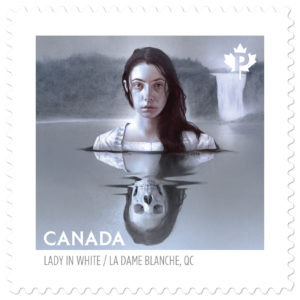
3. More than one waterfall
We usually think of it as a single waterfall, but Montmorency Falls is actually made up of three separate waterfalls. Montmorency Falls Park is built around the Grand Sault, the largest and most impressive of the three waterfalls. The two others are much smaller and rarely appear in pictures. One is natural and the other was formed by the old hydroelectric power station, the remains of which are still visible.
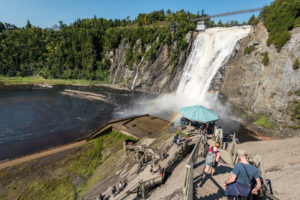
4. Thrills
If peaceful nature walks aren’t your cup of tea, Montmorency Falls is also a great spot for a healthy dose of adrenaline. From the terminal at the foot of the waterfall, you can hitch a ride to the top on a cable car. From there, you can walk the full width of the falls on a suspension bridge, with the water roaring just below your feet. If fear of heights isn’t a problem, you can take the 487-step panoramic staircase back down along the cliff.
True adrenaline junkies won’t want to miss the Via Ferrata. It’s a hybrid of hiking and rock climbing that involves traversing the rock wall using metal holds and a steel cable. There are three routes: Explorateur (beginner, ages 8 and up, 200 m, 2 hr.), Torrent de Montmorency (intermediate, ages 12 and up, 260 m, 2 hr. 30 min.), and Ascension Tyro 120 (intermediate, ages 14 and up, 120 m zip line and 130 m via ferrata, 2 hr. 15 min.). All routes are supervised by certified guides.
And if that’s not enough, you can zoom across the falls on a 300 m double zip line. Are you game?
5. Forbidden love
Located at the top of the cliff, Manoir Montmorency houses an interpretation center, a gift shop, and a restaurant. The current building is actually an exact replica of the original Manoir Montmorency, which went up in flames during renovations in 1993.
Way back in 1780, Governor Frederick Haldimand had the original Manoir built as country house. Later, the Manoir was the setting for a love affair between an extraordinary couple: the Duke of Kent (none other than Prince Edward, son of King George III and father of the future Queen Victoria) and Thérèse-Bernardine Montgenet, a married woman who called herself Julie de Saint-Laurent. Rumor has it that the illicit relationship lasted 27 years.
The Manoir is open seven days a week in high season (spring and summer) and over Christmas. Check to make sure it’s open before leaving, or ask us to inquire for you.
6. Step back for a better view
There are several ways to get to Montmorency Falls. The easiest is by car via Autoroute Dufferin-Montmorency. If you prefer to relax in comfort, there is also a luxury guided bus tour, which leaves from Québec City and stops at Montmorency Falls.
But did you know that the best view of the falls is from Île d’Orléans? Follow the highway until you reach the waterfall, then take the bridge over to the island. It should take about twenty minutes from Québec City. While you’re there, why not drive around the whole island (66.5 km) and stop for an ice cream or some fresh cheese and have a look in the traditional craft shops?
7. Le «pain de sucre»
No, it’s not a candy or a baked good. The refreshing mist that emerges from the falls is very pleasant on hot summer days, but the spray freezes in winter, accumulating on the cliffs and at the foot of the falls, where it forms what is known as the “sugar loaf.” In some years the icy mass can reach epic proportions. It was a popular destination as far back as the 18th and 19th centuries! Here’s a charming painting from around 1870.
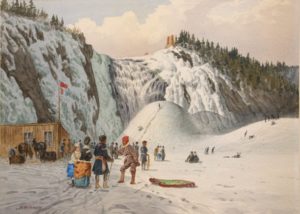
If you want to admire this fleeting wonder in person and take a look at some fearless ice climbers, you’ll have to visit us again next winter.
* * * * *
The staff at Hôtel Château Laurier Québec are here to help: whether you’re looking for the perfect restaurant, directions, travel advice, or an unforgettable gift, we take pride in helping you discover the best that Québec City has to offer.
Planning your Spring Break in Québec City
Everyone looks forward to it, young and old: spring break in March. In Quebec, the very first spring break was in 1979. Students from back then are parents now, and they’re looking for interesting experiences to have with their own children. For the occasion, the concierge team at Hôtel Château Laurier Québec has decided to offer some great recommendations of indoor and outdoor activities to energize you.
Put On Your Scarf, and Let’s Go Out!
The final days of winter in Quebec are full of surprises, but there are often very nice days with higher temperatures and warm rays of sun.
During the school break, the Aquarium de Québec welcomes families with special programming. There are mascots, karaoke, ecological product-making workshops, music, group murals, inflatable games, maple taffy, aquatic life, magic tricks and science-themed escape games, all available from February 29 to March 8. And of course, many indoor pools are open to admire the tens of thousands of aquatic creatures. For the break, the aquarium is open until 8 p.m. every evening, except on the final day. Consult the programming to find out the schedule for each day.

Le Jardin d’hiver is an outdoor path where you can stroll along and discover works of art, illustrations, sculptures, and poetic installations by six artists, both local and visiting. This artistic journey was specifically designed for children to marvel at, taking you from the Old Port to Old Québec City.

In addition, many parks, walking and cross-country ski trails, sledding hills and outdoor skating rinks are located around Québec City, often within walking distance of Hôtel Château Laurier Québec. Don’t hesitate to ask us for advice!
A Seaside Feeling
Even if this is Québec City, why not escape down south, for just a few hours?
Within 20 minutes to the north of the city, Bora Parc in Village Vacances Valcartier is a gigantic indoor water park. There are a variety of slides, water games, a wave pool, pools, a surf wave, hot tubs, an adventure river, rest areas and a restaurant area. It’s a whole lot of fun for the whole family!

You can also just enjoy the facilities at Hôtel Château Laurier Québec a few minutes – or even seconds – from your room! Put on your swimsuit and come and lounge in our indoor saltwater pool (open every day from 6 a.m. to 10 p.m.), enjoy the Finnish sauna, our two outdoor spas and our beautiful four-season indoor garden.
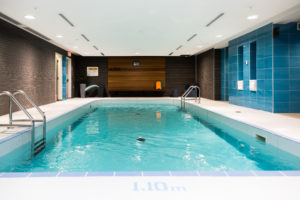
Stay Warm
Prefer to stay warm and dry? Not to worry – here are some suggestions for great experiences to have with your family without getting wet or facing late winter weather surprises!
From February 29 to March 8, 2020, the Festival de cinéma en famille de Québec presents feature films and short films, animated movies and documentaries appealing to a wide range of audiences. For the 9th edition, the programming offers dozens of films, workshops and activities, including film-philosophy, a pyjama screening, an introduction to special effects workshop, a film concert, a movie workshop where you create a magic wand, a brunch screening, meetings of young comic book authors – and even an intriguing bicycle movie, where you have to pedal to keep the battery charged to watch the film!

Escape rooms are very popular these days. If you’re not familiar with the concept, which is very popular with teens, then spring break is a great opportunity to get started! You are “locked up” in a room you have to escape from in a certain amount of time, using a series of clues. One of the most fun strategies is to play as a team. Some places offer even more: for example, the Stadaconé Distillery created an immersive game that takes us back to the era of New France, where we have to find a medicine to cure a captain suffering from scurvy! The visitors are invited to discover the distillery’s services, as adults taste the alcoholic products, and kids can learn to recognize the different fragrances of flowers, grains and fruits used in the composition of the gins.
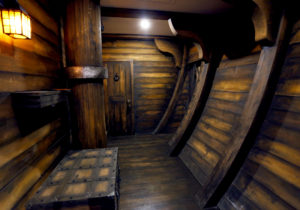
Do you have military history buffs in your family? Take advantage of your break in Québec City and discover the Musée Royal 22e Régiment, at the Citadelle of Quebec. The permanent exhibit “Je me souviens” reveals a wealth of fascinating information on military life in Québec City. The medals room, interactive displays, and the objects on display tell the story of a rich period in history. There’s also a family exhibition where you can discover the many animals (horses, pigeons, dogs and even goats) that accompanied the soldiers on missions abroad and in training!
* * * * *
As you can see, our beautiful Québec City has a lot to offer! We’ll be happy to offer you more information – for example, great restaurants to visit with family or other museums to attend. We hope that this break in Québec City will bring everyone, young and old, the recharge they need to end the school year in style!
Quebec Winter Carnival: Turning Winter Into a Celebration
In Quebec almost anything can be an opportunity to celebrate – there are over 600 festivals in the province each year! Even so, the Quebec Winter Carnival is a festival unlike any other. After all, the winter here lasts four to six months, making Québec City something of a capital of snow. The Quebec Winter Carnival is the oldest winter festival in Canada. This year, from February 7 to 16, many activities will allow festival goers, both locals and tourists, to fully experience the joys Quebec’s winter has to offer. So, we decided to offer you a brief history of this extraordinary celebration as well as our suggestions for the best ways to take part yourself!
A Festive History
Carnivals are an old European institution, associated with the religious calendar and Mardi Gras. This celebration, however, took on an additional meaning in Québec City – a sort of truce in our battle against the cold! The idea of organizing a festive event in the heart of winter in Québec City roughly dates back to the 17th century, during the New France era. But the first real Carnival was held in 1894.
People gathered in the city streets to have fun, laugh, sing and be entertained, as if to snub the cold! Trumpets were played. It featured elements that, in some cases, would become iconic: the ice palace, snow sculptures, a night-time parade of floats, skating, snowshoeing, sleigh rides, dances and sports competitions – including dog sled races and ice canoe races on the St. Lawrence River.

Credit: Francis Gagnon. Courtesy of Office de Tourisme de Québec
During the second carnival in 1896, discounted Canadian Pacific Railway fares enabled visitors from New England, Ontario and even Western Canada to visit Québec City and participate in the celebration.
Rise of the Modern Carnival
As a result of the wars and economic crises, the Carnival didn’t originally take place every year. It was organized sporadically until the 1950s. Starting in 1955 the winter festival truly became an annual event, considered a means to promote winter tourism in the city. The event was marked by festivities, sports and games, as well as the night parade. The highly prized Queen’s Ball was held in the ballroom of Château Frontenac. Huge fireworks closed the party.

It was also in the mid-1950s that Bonhomme appeared: all white, wearing a red cap, with his waist wrapped in a beautiful sash. He symbolizes the “joie de vivre,” to the delight of the young and old. Days before the Carnival, Bonhomme visits children in daycare centres, the elderly, and prisoners in jail. When he officially enters the city, the mayor of Québec City gives him the keys to the city. Bonhomme then takes part in virtually all Carnival festivities. Throughout the year, he acts as an ambassador for the Quebec Winter Carnival, travelling around the world to promote the event! A life-size model of Bonhomme is installed in the lobby of Hôtel Château Laurier Québec, very close to the concierge office. Don’t forget to take a picture during your stay!
After the 1950s, the Carnival expanded and welcomed an increasing number of visitors. The 1960s and 1970s introduced ice-skate barrel jumping competitions, a Pee-Wee hockey tournament, go-kart and snowmobile races, and even a moustache contest! In 1964, 260,000 people visited Québec City for the Carnival; in 1994, almost a million visitors are present, of whom more than 20% came from outside Quebec – mostly from Europe and the United States.
The Carnival boasts an excellent reputation and a remarkable longevity. It’s become a classic of Québec City, a true trademark recognized on the international scene.
What’s On at the Carnival This Year
Once again this year, the Quebec Winter Carnival offers a variety of activities to tame our wintry northern landscape.
Discover the different spectacles that highlight the fun of winter: the maze, the ice sculpting demonstrations and the impressive ice sculpture route, as well as the unmissable Bonhomme’s Palace! Technological activities are also available, including the Pixel immersive experience, against a backdrop of arcade games from the 80s and 90s.

If you’re feeling a little more energetic, the programming includes Shoot & Putt tournaments (a hybrid between minigolf and field hockey), a friendly axe throwing competition, 4-on-4 hockey games with the Goon’s League, and sledding on the Christie Descent, a 300-foot-long track that includes a bend!
Finally, foodies and gourmets can benefit from wonderful activities that will delight their taste buds. The sugar shack allows you to sample maple products, including the iconic maple taffy on snow. Beaver Tail pastries are also available for your sweet tooth. In short, the food on offer, including mixology and a Carnival “caribou” cocktail recipe, is truly excellent.
Things You Won’t Want to Miss
While most features of the Quebec Winter Carnival programming are ongoing throughout the event, others are more exclusive.
For instance, on Friday, February 7, a Hip-Hop Party will welcome several artists from the current Quebec rap scene, including Alaclair Ensemble. For electronic music lovers, they will be transported by the Electro Frette evening on Friday, February 14, which will feature five young female DJs from cities including Los Angeles, Paris and Kiev. Other musical performances are planned throughout the Carnival, from the blues to folkloric rigodon. So, take the time to check out the programming for the various stages.
On Sunday, February 9, don’t miss the canoe race, which brings together several teams, including one made up of competitors from Hôtel Château Laurier Québec!
And of course, we can’t forget the long-awaited Parade, on February 8 and 15, which is always a highlight of the Carnival. It’s like a moving circus, with dance, music, fabulous characters and energetic performances. The two parades take place on Grande Allée Street, right on our doorstep.

Credit : Audet Photo. Courtesy of Office de Tourisme de Québec
After all the time spent with our cheeks pink from the wind, what a pleasure it is to enter a cafe or a bistro to warm up with a good soup, a hot chocolate or, to be truly Quebecois, a poutine!
* * * * *
The concierge team at Hôtel Château Laurier Québec is committed and happy to help you with all your wishes: whatever your needs, do not hesitate to contact us. Whether for business, family, girls’ night out or activities for couples, we will ensure your stay in Québec City is a true pleasure.